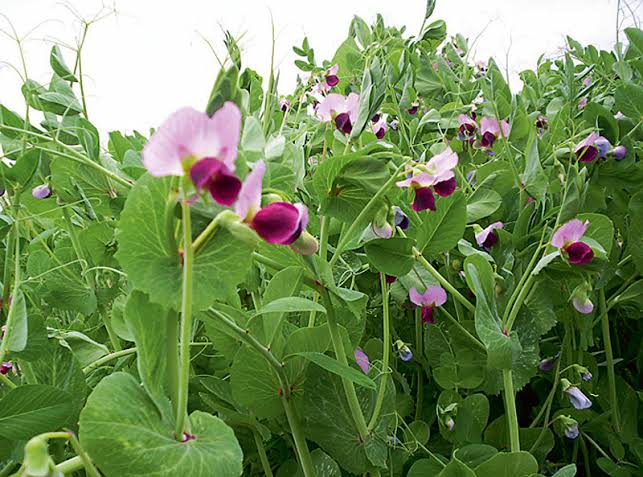Cows Know Best? The Unsavory Tale of Estonian Vetch: An In-depth Analysis
Among the rolling fields of Estonia, the intriguing behavior of dairy cows is making us question our understanding of animal instincts and crop cultivation. In an interesting twist of bovine behavior, local cows are refusing to eat field peas, or vetch (Vicia species), a crop commonly grown in the region.

Among the rolling fields of Estonia, the intriguing behavior of dairy cows is making us question our understanding of animal instincts and crop cultivation. In an interesting twist of bovine behavior, local cows are refusing to eat field peas, or vetch (Vicia species), a crop commonly grown in the region. However, these same cows eagerly munch on garden peas offered by the farmers' wives. What is it about vetch that turns off our hoofed friends? Are Estonian cows smarter than we think? Let's dive in to find out.
A Clash of Taste Buds
It is no secret that cows are selective eaters. Despite being often depicted as indiscriminate grazers, bovine dietary preferences are complex. Factors such as taste, smell, texture, and even color can influence what a cow decides to eat. Therefore, the initial hypothesis is simple: Estonian vetch might just not taste good to the cows. But, why then do humans pick and eat these peas while walking by the fields?
The taste discrepancy between humans and cows is attributed to the unique physiological and biological makeup of each species. Humans have around 9,000 taste buds, whereas cows have approximately 25,000. Furthermore, cows' taste buds are uniquely adapted to their herbivorous diet, enabling them to detect nuances in taste that we simply cannot. Perhaps, what tastes unremarkable, or even pleasant, to a human might be unpleasantly intense or unpalatable to a cow.
The Science of Vetch
However, taste alone does not explain the complete picture. We need to dive deeper into the vetch itself. Vetch, particularly hairy vetch (Vicia villosa), is a common cover crop in Estonia, known for its nitrogen-fixing capabilities and its resilience to cold climates. It is typically grown to improve soil health rather than as fodder for livestock.
Many varieties of vetch, including some grown in Estonia, are known to contain antinutritional factors (ANFs) - compounds that reduce the nutritional value of the plant when consumed. These ANFs can range from simple digestive inhibitors, which prevent the absorption of nutrients, to more harmful compounds such as lectins and tannins, which can cause bloating, diarrhea, and other health issues in livestock.
The Vigilance of Bovine Instincts
This brings us to the crux of the matter - the keen survival instincts of cows. Over the course of their evolution, cows have developed an aversion to plants containing harmful substances, including ANFs. The refusal of the cows to eat the vetch might be an instinctive rejection of the ANFs contained within.
In contrast, garden peas are a safe and nutritious option for cows, being high in protein and fiber and relatively free of harmful compounds. The cows' preference for garden peas over vetch could be seen as a demonstration of their natural instinct to avoid potential harm and seek out beneficial foods.
Cows vs. Humans: A Matter of Knowledge?
Does this mean that Estonian cows are more discerning than the average Estonian? Not necessarily. The difference lies in knowledge and instinct. Humans, being aware of the possible presence of ANFs in vetch, usually cook these peas before eating to neutralize the harmful compounds. Cows, on the other hand, rely on their instincts to avoid potentially harmful foods. It's not a question of intelligence, but of adaptation and survival strategy.
Lessons from the Pasture
The story of the Estonian cows and the vetch reveals the intricate dance of ecology, animal behavior, and agricultural practices. It's a testament to the adaptive power of nature and a call to understand more deeply the crops we grow and the animals we rear.
Could there be potential improvements in the cultivation of vetch, making it more suitable for bovine consumption? Perhaps we can breed varieties with lower levels of ANFs, or develop treatment methods to make the crop more palatable and nutritious for cows.
Whatever the solution might be, the cows have given us food for thought. Their discerning palates serve as a reminder to respect the knowledge and instincts of the animals we share our world with. In the dance of nature, they have their unique rhythm and wisdom. And in understanding them, we learn more about the world and our place in it.
In the fields of Estonia, the cows have spoken, or rather, they've refused to eat. It's up to us to heed their wisdom and respond, fostering a more harmonious, sustainable, and insightful relationship with the land we till and the animals we care for.
Lectins and Tannins: Unveiling the Hidden Dangers in Our Fields
In our discourse, we delved into the intriguing case of Estonian cows refusing to consume vetch. We found that the likely culprits behind this behavior were antinutritional factors (ANFs) found within the vetch, particularly lectins and tannins. Now, we'll take a closer look at these substances, exploring what they are, what they do, and why our bovine friends might be wise to avoid them.
Unmasking Lectins
Lectins are a type of protein found in a wide variety of foods, particularly in legumes, whole grains, and some fruits and vegetables. They have a unique ability to bind to sugars, allowing them to interact with our cells in ways that other proteins cannot.
At their best, lectins play vital roles in biological functions, from cell-cell interaction to immune response. However, not all lectins are beneficial. Some can bind to the cells lining our intestines, interfering with nutrient absorption, damaging the intestinal wall, and even triggering inflammatory responses. These actions could potentially lead to digestive issues, such as bloating, diarrhea, and nausea.
For ruminants like cows, the impact of lectins could be even more severe. The ruminant digestive system, which relies on a delicate balance of microorganisms to break down food, is particularly sensitive to lectin-induced disruption. This could potentially lead to severe gastrointestinal issues, lower nutrient absorption, and overall poorer health in the animals.
The Tannin Tale
Tannins, on the other hand, are a group of naturally occurring compounds found in various plants, including vetch. They are the same substances that give a cup of tea its astringency or a bite of unripe fruit its mouth-puckering quality.
Like lectins, tannins also have their pros and cons. Some tannins are beneficial, acting as antioxidants, while others can have a detrimental effect on health. In high amounts, tannins can bind with proteins and other important nutrients, inhibiting their absorption in the body.
In livestock, high tannin consumption can lead to reduced growth, lower feed intake, and impaired metabolism. In severe cases, it can even cause damage to the liver and kidneys. Thus, it's not surprising that cows, with their instinctive understanding of their dietary needs, might turn their noses up at high-tannin foods like vetch.
The Way Forward: Respecting Bovine Wisdom
Understanding the effects of lectins and tannins sheds new light on the bovine behavior we observed. It's clear that our cows are not just being fussy. They're instinctively avoiding substances that could be harmful to their health.
For us, the stewards of the land and caretakers of these animals, this knowledge brings new responsibility. It urges us to consider more carefully what we plant and how we feed our livestock. Perhaps we need to adjust our farming practices to align more closely with the innate wisdom of the creatures in our care.
The fields of Estonia hold a lesson not just for our cows, but for us as well. Nature has a wisdom of its own, and we would do well to listen. Whether we're planting our next crop or feeding our livestock, let's take a page from our bovine friends' book: Be discerning, respect our bodies, and don't be afraid to turn up our noses at things that could harm us.
From Pasture to Plate: The Journey of Harmful Compounds and the Future of Sustainable Eating
As previously discussed, we've ventured into the complex world of bovine dietary preferences, unveiling why cows may reject specific plants, particularly the vetch found in Estonian fields. At the heart of this behavior are antinutritional factors (ANFs) such as lectins and tannins, which hold potential harm to a cow's health. Continuing our exploration, we transition from pasture to plate, investigating how these substances might infiltrate our own diets through the meat we consume. Ultimately, we turn our gaze towards the rising stars of alternative protein sources, like insects, as they offer a more sustainable route for our dietary needs.
The Pathway to Our Plates
The conventional food chain works in a relatively straightforward manner: plants absorb nutrients from the soil, animals eat the plants, and humans consume the animals. However, this process is not exclusive to beneficial nutrients—it also applies to harmful compounds.
When cows eat vetch rich in ANFs like lectins and tannins, these compounds can end up in the animals' tissues, primarily in the muscles, which we consume as meat. Although our bodies have defense mechanisms against these harmful substances, repeated or high-level exposure can potentially lead to adverse health effects, similar to those experienced by the cows themselves.
The Tricks of the Trade
How do farmers get cows to eat these potentially harmful feeds? The answer lies in the art and science of animal feed formulation. To overcome the taste and harmful effects of ANFs, feed producers often treat or process the feeds in various ways.
Heat treatment, for instance, can degrade lectins and tannins, reducing their levels in the feed. Additionally, certain additives can bind to these compounds, neutralizing them or preventing their absorption in the animal's gut.
However, the specifics of these processes are often closely guarded trade secrets, varying from one feed producer to another. Nevertheless, it's clear that considerable effort is put into ensuring that these feeds are safe and palatable for livestock.
Towards a Sustainable Diet
Despite these efforts, the question remains: Should we continue to rely on livestock for our primary protein source, given the environmental and potential health impacts? This question leads us to the burgeoning field of alternative proteins, with insects leading the charge.
Insects are highly nutritious, rich in proteins, and essential micronutrients. They also have a much lower environmental footprint compared to traditional livestock, requiring less land, water, and feed, and producing fewer greenhouse gases.
Switching to insects as a protein source might seem daunting, especially for Western cultures where insect-eating isn't traditionally accepted. However, with increasing environmental concerns and the global need for sustainable protein sources, insects are gaining momentum as a viable, eco-friendly alternative.
Embracing the Future of Food
From understanding the eating habits of cows to exploring the journey of harmful substances from pasture to plate, and finally considering alternative protein sources, our exploration highlights the need for conscious, sustainable eating.
As we move towards the future, it's important to reassess our food systems, consider our dietary choices, and understand their wider impact. Whether it's by choosing pasture-raised meats, reducing our meat consumption, or embracing alternative protein sources, each of us has a role to play in building a sustainable food future.
The wisdom of the cows, it seems, extends far beyond the pastures of Estonia. Their selective eating habits remind us of the interconnectedness of our food systems, and the importance of respecting the natural world in our quest for nourishment. As we stand at the precipice of dietary change, let's take a leaf, or rather a bug, out of nature's book, embracing sustainability, adaptability, and respect for our Earth.




